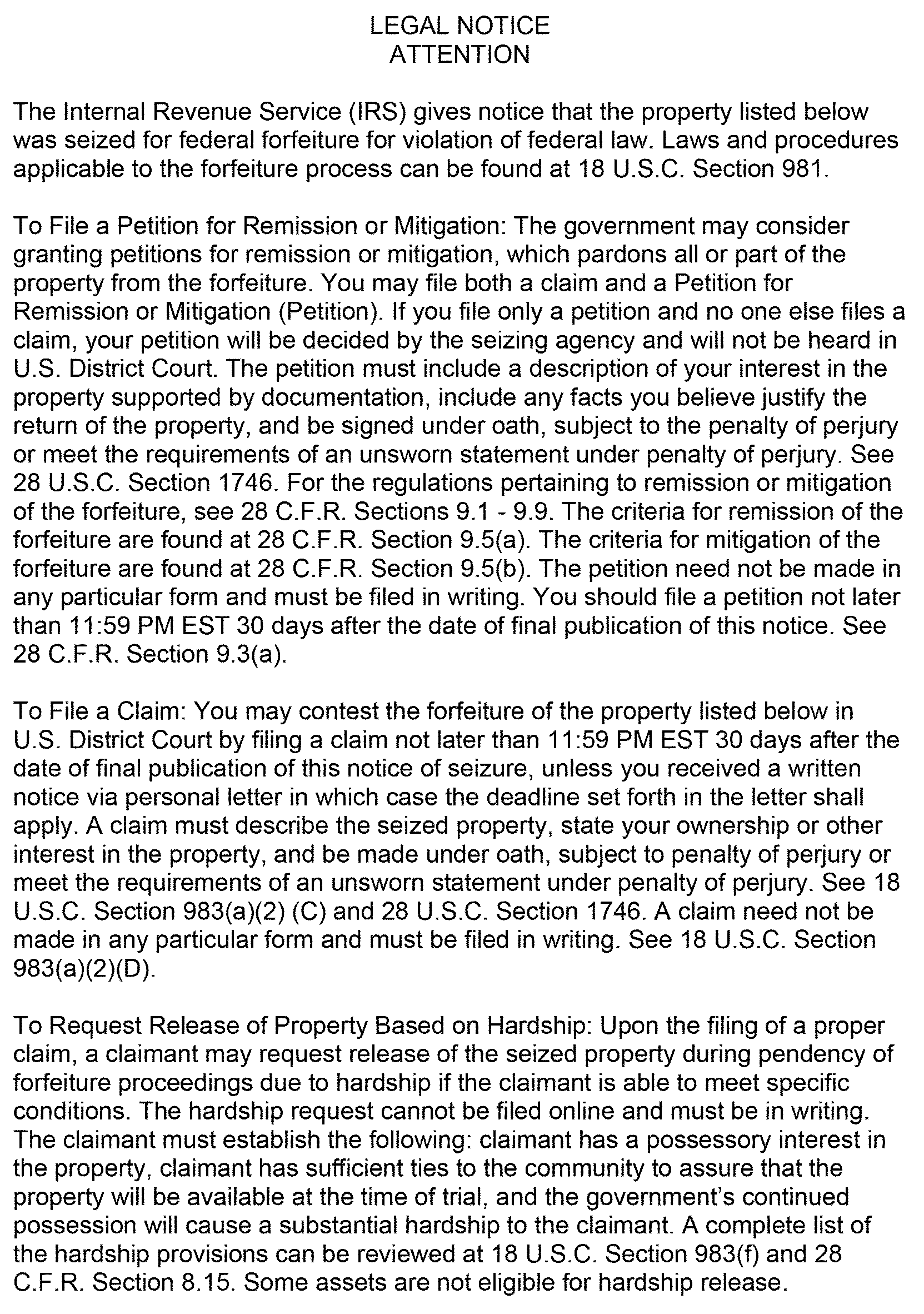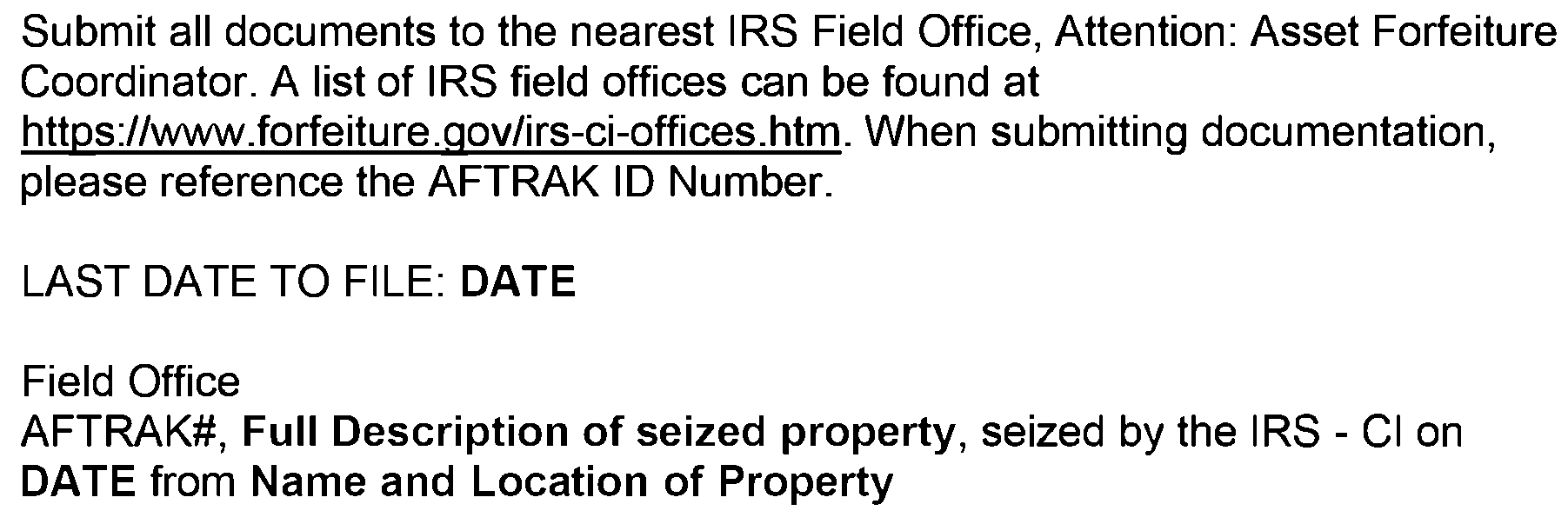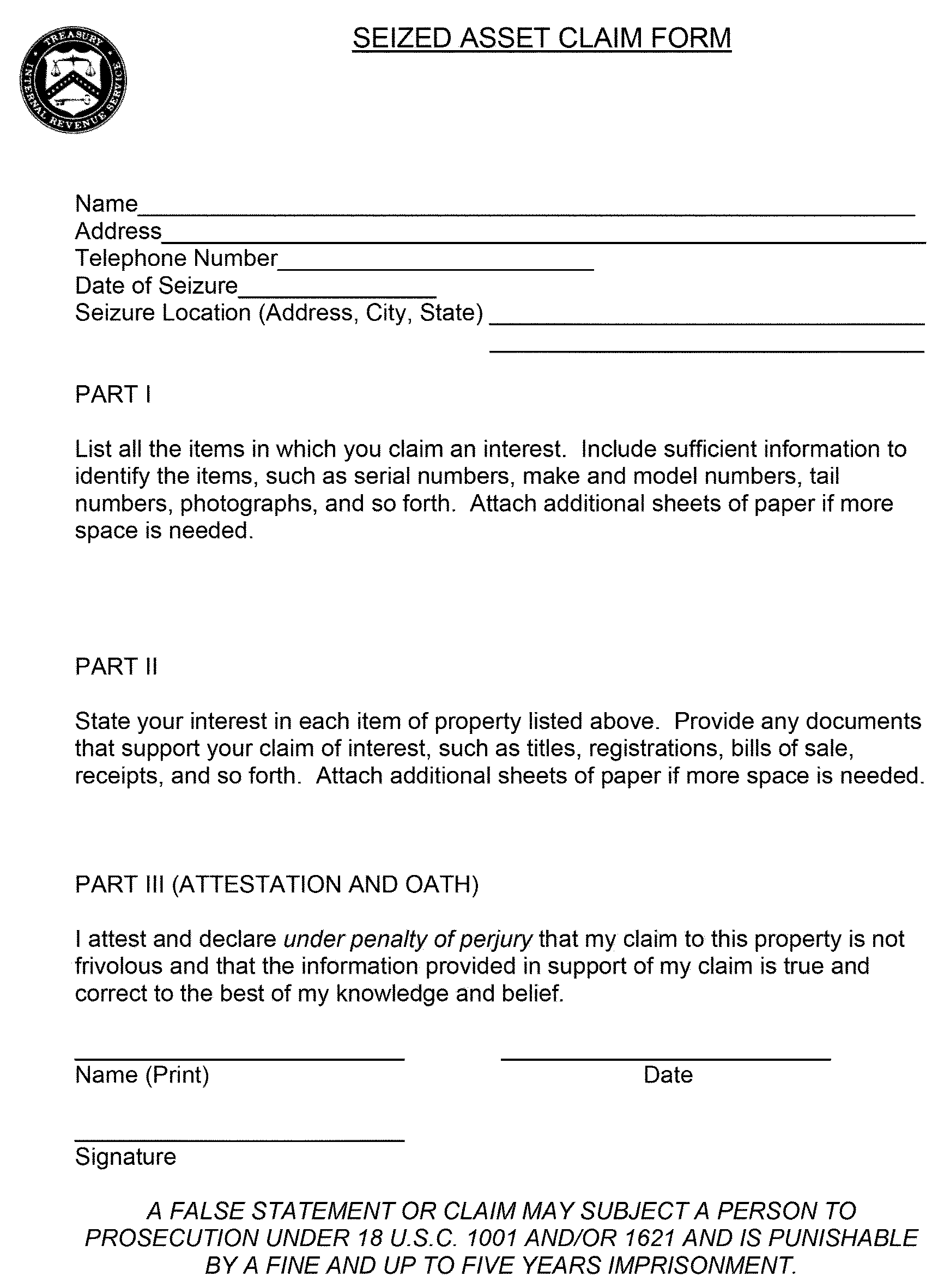- 9.7.2 Civil Seizure and Forfeiture
- 9.7.2.1 Program Scope and Objectives
- 9.7.2.1.1 Background
- 9.7.2.1.2 Authority
- 9.7.2.1.3 Roles and Responsibilities
- 9.7.2.1.4 Program Management
- 9.7.2.1.5 Program Controls
- 9.7.2.1.6 Terms and Acronym Table
- 9.7.2.1.7 Related Resources
- 9.7.2.2 Civilly Forfeitable Property
- 9.7.2.3 Statute of Limitations
- 9.7.2.4 Seizure of Property for Civil Forfeiture
- 9.7.2.5 Pre-Seizure Planning
- 9.7.2.6 Methods of Seizure for Civil Forfeiture
- 9.7.2.6.1 Seizure Warrant
- 9.7.2.6.2 Warrant of Arrest In Rem
- 9.7.2.6.3 Adoptions
- 9.7.2.6.4 Restraining Orders and Protective Orders
- 9.7.2.6.5 Seizures Without a Warrant
- 9.7.2.6.6 Forfeiture of Proceeds
- 9.7.2.7 Administrative Forfeiture Proceedings
- 9.7.2.7.1 Property Subject to Administrative Forfeiture
- 9.7.2.7.2 Notice
- 9.7.2.7.3 Time Limits for Sending Notice
- 9.7.2.7.4 Notice Extension
- 9.7.2.7.5 Contents of Notice
- 9.7.2.7.6 Publication of Notice of Seizure
- 9.7.2.7.7 Claim
- 9.7.2.7.8 Deadline for Filing a Claim
- 9.7.2.7.9 Setting the Forfeiture Date
- 9.7.2.7.10 Content of Claim
- 9.7.2.7.11 Form of Claim
- 9.7.2.7.12 Review of Sufficiency of Claim
- 9.7.2.7.13 Declaration of Forfeiture
- 9.7.2.8 Civil Judicial Forfeiture Proceedings
- 9.7.2.8.1 Property Subject to Civil Judicial Forfeiture
- 9.7.2.8.2 Complaint for Forfeiture
- 9.7.2.8.3 Time Limitations
- 9.7.2.8.4 Execution of Arrest In Rem Warrant
- 9.7.2.8.5 Real Property
- 9.7.2.8.6 Lis Pendens
- 9.7.2.8.7 Notice and Processing of Civil Forfeiture Action
- 9.7.2.8.8 Burden of Proof
- 9.7.2.8.9 Judgment/Order of Forfeiture
- Exhibit 9.7.2-1 Request for Adoption of State or Local Seizure
- Exhibit 9.7.2-2 Seizure Notice Letter/Intent to Forfeit - Title 18
- Exhibit 9.7.2-3 Seizure Notice Letter/Intent to Forfeit - Title 31
- Exhibit 9.7.2-4 Notice of Seizure (forfeiture.gov)
- Exhibit 9.7.2-5 Seized Asset Claim Form
- Exhibit 9.7.2-6 Form 1570 - Declaration of Forfeiture
- 9.7.2.1 Program Scope and Objectives
Part 9. Criminal Investigation
Chapter 7. Asset Seizure and Forfeiture
Section 2. Civil Seizure and Forfeiture
9.7.2 Civil Seizure and Forfeiture
Manual Transmittal
January 16, 2025
Purpose
(1) This transmits revised IRM 9.7.2, Civil Seizure and Forfeiture.
Material Changes
(1) Added required Internal Controls to comply with IRM 1.11.2.2.4, Address Management and Internal Controls and IRM 1.4.2, Resource Guide for Managers Monitoring and Improving Internal Controls.
(2) Removed § throughout IRM.
(3) Subsection 9.7.2.5 removed “pre-seizure planning” and added “factors to consider in the decision to seize property and commence a forfeiture action”.
(4) Subsection 9.7.2.6.3(3) removed “The Executive Office of Asset Forfeiture, Department of the Treasury“.
(5) Subsection 9.7.2.7.5(4) removed “Treasury Executive Office of Asset Forfeiture”.
(6) Subsection 9.7.2.7.11(2) removed “Treasury Executive Office of Asset Forfeiture, Department of the Treasury”.
(7) Subsection 9.7.2.9.4(1) removed “Guidance and procedures for the preparation, planning, execution, and return of process for warrants of arrests in rem are contained in TEOAF Directive 23, Execution of Warrants of Arrest In Rem by Treasury Law Enforcement Agencies.”
(8) Editorial changes made throughout the IRM for clarity.
Effect on Other Documents
This IRM supersedes IRM 9.7.2 dated October 16, 2023.Audience
Criminal InvestigationEffective Date
(01-16-2025)Shea C. Jones
Deputy Chief, Criminal Investigation
for
Guy A. Ficco
Chief, Criminal Investigation
-
Purpose: This section provides guidance on the civil seizure and forfeiture process, to include aspects to consider whether utilizing or proceeding with an administrative seizure or judicial forfeiture method.
-
Audience: All Criminal Investigation (CI) employees.
-
Policy Owner: Director, Asset Recovery and Investigative Services (ARIS).
-
Program Owner: Director, ARIS.
-
Primary Stakeholders: All CI employees.
-
Contact Information: To make changes to this IRM section email CIHQIRM@ci.irs.gov.
-
Civil forfeiture is an in rem proceeding against the property itself, not the owner of the property. Civil forfeiture is a process that is separated from, and not dependent on, a criminal prosecution. Civil forfeiture can proceed administratively or judicially.
-
Treasury Directive 15-42 delegates to the Commissioner, IRS seizure and forfeiture authority relating to violations of:
-
Title 31 Unites States Code (USC) 5313 and 5324 (Bank Secrecy Act). Title 31 5324 investigations involving “legal source” structuring, refer to IRM 9.7.1.3.1(6) and (7).
-
Title 18 USC 1956 and 1957 (where the underlying conduct is subject to investigation under Title 26 or the Bank Secrecy Act).
-
-
Treasury Directive 15-42 also delegates seizure authority to IRS relating to any other violation of 18 USC 1956 or 1957, if the agency with investigatory authority is not present to make the seizure. Property seized in these situations must be turned over to the agency with investigative authority.
-
Treasury Executive Office for Asset Forfeiture (TEOAF) has determined that CI can exercise judicial and/or administrative forfeiture authority under 18 USC 981(a)(1)(C) in instances where CI is pursuing a money laundering investigation and forfeiture of the property under 981 is incidental to the investigation of the subject or financial transaction(s) involved. Concurrence of the Assistant United States Attorney (AUSA) assigned to the investigation is required.
-
With respect to matters discovered within the investigatory jurisdiction of a Department of Justice (DOJ) bureau or the Postal Service, IRS shall adhere to the provisions in the “Memorandum of Understanding Among the Secretary of the Treasury, the Attorney General, and the Postmaster General Regarding Money Laundering Investigations”, dated August 16, 1990.
-
CI does not have investigatory jurisdiction for forfeitures under 18 USC 1955 (making it unlawful to conduct, finance, manage, supervise, direct, or own all or part of an illegal gambling business).
-
The Director, ARIS is responsible for developing, maintaining, and overseeing this IRM and ensuring compliance with current policies and procedures.
-
The Director, ARIS will:
-
Review this IRM annually.
-
Update this IRM when content is no longer accurate and reliable to ensure employees correctly complete their work assignments.
-
Incorporate all permanent interim content into the next version of this IRM section prior to the expiration date.
-
-
The Director, ARIS will review and oversee their program as well as ensuring employee compliance with all applicable elements of this IRM.
-
The table lists commonly used acronyms and their definitions:
Acronym Definition AFC Asset Forfeiture Coordinator ARIS Asset Recovery & Investigative Services AUSA Assistant United States Attorney CI Criminal Investigation DFO Director of Field Operations DOJ Department of Justice Fed. R. Crim. P. Federal Rules of Criminal Procedure IRM Internal Revenue Manual SAC Special Agent in Charge SUA Specified Unlawful Activity TEOAF Treasury Executive Office for Asset Forfeiture USAO United States Attorney’s Office USC United States Code
-
All civil forfeiture statutes presently in effect are in rem statutes in which the property itself, not the owner of the property, is accused of wrongdoing. For that reason, only property that was actually used to commit, or was derived from, an offense, or property traceable to it, is subject to forfeiture.
-
Title 18 USC 981 governs forfeiture relating to money laundering, unlicensed money transmitting businesses (18 USC 1960), foreign crimes, proceeds from other criminal violations including offenses constituting 'specified unlawful activity' (as defined in 18 USC 1956(c)(7) and 18 USC 1961(1)), automobile theft and "carjacking" , and assets of a domestic or international terrorist.
-
CI has investigatory jurisdiction under 18 USC 981(a)(1)(A) for forfeitures relating to money laundering. CI can also exercise forfeiture authority under 981(a)(1)(C) in instances where:
-
CI is pursuing a money laundering investigation and forfeiture of the property under 981 is incidental to the investigation of the subject or financial transaction(s) involved.
-
The Assistant United States Attorney (AUSA) assigned to the investigation concurs with use of this provision.
-
-
CI has investigatory jurisdiction under 31 USC 5317(c)(2) for the civil forfeiture of property involved in violation of the currency transaction reporting statutes, 31 USC 5313 or 5324. This includes the civil forfeiture of property involved in violations of 31 USC 5324(b), the penalty provision for the reporting requirements imposed under 31 USC 5331 relating to coins and currency received in a non-financial trade or business (Form 8300).
-
Title 31 USC 5317(c)(2) also provides for the civil forfeiture of any property involved in any conspiracy to commit a violation of 31 USC 5313 or 5324 in violation of the general conspiracy statute, 18 USC 371.
-
Title 18 USC 984 is a statutory exception to the usual rule regarding tracing that would otherwise apply in 18 USC 981(a)(1)(A) or 31 USC 5317(c)(2) investigations.
-
Title 18 USC 984 applies in any civil forfeiture action in which the subject property is cash, monetary instruments in bearer form, funds deposited in an account in a financial institution, or precious metals. Any identical property found in the same place or account as the property involved in the offense that is the basis for the forfeiture shall be subject to forfeiture under 18 USC 984.
-
For example, suppose a person placed $10,000 in laundered funds in a bank account on Monday and the account is seized for civil forfeiture on Friday. Suppose also that at the time of the seizure, the balance in the account is $10,000, but that in between, on Wednesday, the balance dropped to zero and $10,000 in unlaundered funds are deposited, so that the $10,000 seized cannot be strictly traced back to the money laundering offense. In general, the $10,000 seized on Friday was not the same money as the laundered funds that were placed in the account on Monday. Failing the tracing requirement, the government would not be able to forfeit the $10,000. Under 18 USC 984, the government may forfeit the $10,000 from that account without regard to fluctuations in the balance in the account.
-
-
A forfeiture action is commenced pursuant to 18 USC 981(a)(1)(A) or 31 USC 5317(c)(2) while invoking 18 USC 984 to by-pass the tracing rule.
-
Any civil forfeiture action pursuant to 18 USC 984 must be commenced not more than 1 year from the date of the offense.
-
Any civil forfeiture action must be commenced within 5 years after the time when the alleged offense was discovered, or within 2 years after the time when the involvement of the property in the alleged offense was discovered, whichever was later.
-
The process of civil forfeiture begins with the actual or constructive seizure of the allegedly "guilty" property. Actual seizure of tangible personal property frequently occurs prior to the initiation of a formal civil forfeiture action.
-
Because there are numerous issues involved beyond the legality to execute a seizure and commence a forfeiture action, IRM 9.7.4, Pre-Seizure Planning, has been devoted entirely to factors to consider in the decision to seize property and commence a forfeiture action.
-
Property subject to forfeiture under 18 USC 981(a)(1) may be seized pursuant to the methods described below as authorized in 18 USC 981(b)(1), (b)(2), and (j).
-
Property subject to forfeiture may be seized pursuant to a warrant obtained in the same manner as provided for a search warrant under Rule 41 of the Federal Rules of Criminal Procedure (Fed. R. Crim. P. 41). The AUSA must submit an application for the seizure of particular property, as well as a special agent's sworn affidavit setting forth the facts that provide probable cause for the seizure.
-
A seizure warrant may be issued in any judicial district in which a civil forfeiture action against the property may be filed, and may be executed in any judicial district in which the property is found. In the event that an out-of-district seizure is contemplated, it must involve consultation and coordination with the US Attorney's Office and the field office within the judicial district in which the seizure is to occur.
-
Title 18 USC 985 requires that civil forfeiture of real property proceed judicially. Except as provided in the statute, the real property that is the subject of a civil forfeiture action cannot be seized before entry of an order of forfeiture.
Note:
The owners or occupants of the real property cannot be evicted absent notice and a hearing or an ex parte determination that there is probable cause for the forfeiture and that there are exigent circumstances that permit the seizure of the property without prior notice and an opportunity for the property owner to be heard.
-
Property may be seized where a complaint for forfeiture has been filed in US district court and the court has issued a warrant of arrest in rem. A warrant of arrest in rem must be issued for the arrest of any asset that is to be forfeited in a civil judicial forfeiture proceeding. It is not appropriate to use a warrant of arrest in rem when property is to be forfeited administratively, because it is issued only after judicial forfeiture proceedings have been formally commenced.
-
A warrant of arrest in rem is issued by the clerk of the court when a complaint of forfeiture is filed. The complaint must describe with "reasonable particularity" the property involved, the place of seizure, and other allegations as required by the statute on which the forfeiture is based.
-
A warrant of arrest in rem is necessary for civil forfeiture even if the property is already in custody pursuant to an earlier seizure, in order to provide the court with jurisdiction over the property.
-
Where a civil forfeiture action is filed in a judicial district other than the judicial district where the property is located, the court's authority to have a warrant of arrest in rem served on the property is based on the nationwide service provision of 28 USC 1355(d).
-
State and local agencies generally request federal adoption when, after making a seizure, they determine that a state forfeiture proceeding is not possible or that a federal forfeiture proceeding would be more advantageous.
-
Adoptive seizures are only those seizures where 100% of the pre-seizure activity and related investigations are performed by the state or local seizing agency before a request is made for adoption. There must be a state violation and a federal basis for forfeiture in order for the seizure to be true adoption. Seizures resulting from joint investigations or task force cases are not adoptive seizures.
-
The TEOAF Directive Number 34, Policy Limiting the Federal Adoption of Seizures by State and Local Law Enforcement Agencies, sets general policies and procedures with respect to adoptions. Directive Number 34 is located on the Asset Recovery & Investigative Services (ARIS) website. The policies covered include:
-
Circumstances for considering adopting a seizure,
-
List of property that implicates public safety concerns,
-
List of property that is prohibited from adoption,
-
Requirements for an adoption of property that is not listed; however, believes property implicates public safety,
-
Circumstances for which this policy does not apply.
-
-
The general adoption procedures in Directive Number 34 cover the federal adoption form, Request for Adoption of State or Local Seizure (see Exhibit 9.7.2-1).
-
CI requires a legal review of the adoption by a Criminal Tax (CT) Attorney prior to taking custody of any seized assets from a state or local agency. CI also requires that a seizure warrant be obtained in state and local adoptions.
-
The court may enter a restraining order to take any other action to preserve the availability of property subject to civil forfeiture upon the filing of a civil forfeiture complaint.
-
The court may also enter a restraining order to take any other action to preserve the availability of property subject to civil forfeiture before the filing of a complaint if, after notice to persons with an interest in the property and opportunity for a hearing, the court determines that:
-
There is a substantial probability that the United States will prevail on the issue of forfeiture and that failure to enter the order will result in the property being destroyed, removed from the jurisdiction of the court, or otherwise made unavailable for forfeiture.
-
The need to preserve the availability of the property through the entry of the requested order outweighs the hardship on any party against whom the order is to be entered.
-
-
An order entered before the filing of a complaint is effective for not more than 90 days, unless extended by the court for good cause shown.
-
A temporary restraining order may be entered upon application of the United States without notice or opportunity for a hearing before the filing of a complaint. A temporary restraining order shall expire not more than 10 days after the date it is entered, unless extended for good cause shown or unless the party against whom it is entered consents to an extension for a longer period.
-
Property subject to forfeiture, other than real property, may be seized without a warrant if there is probable cause to believe that the property is subject to forfeiture and:
-
The seizure is made pursuant to a lawful arrest or search, and
-
Exigent circumstances exist creating the need to act promptly to prevent removal, destruction, or concealment of forfeitable property.
-
-
Special agents should attempt seizures without a warrant only after carefully considering the circumstances with which they are confronted, and should consult legal counsel, if time permits. Such seizures should only be made if the exigent circumstances prohibiting the timely obtainment of a seizure warrant can be clearly documented.
-
Whenever possible, CI's forfeiture activity will concentrate on utilizing 18 USC 981(a)(1)(A). However, there are situations where the subject is involved in money laundering activity; but, due to varying circumstances, only a portion of the assets can be traced to specific money laundering transactions. It would be inefficient to pursue forfeiture under two separate statutes, a portion of the assets under 18 USC 981(a)(1)(A) (Financial Transaction) and a portion under 18 USC 981(a)(1)(C) (Constitutes or is Derived from Proceeds). With the concurrence of the AUSA assigned to the investigation, 18 USC 981(a)(1)(C) can be used for the entire forfeiture. This forfeiture authority would also apply to Specified Unlawful Activity (SUA) proceeds seized during a legitimate money laundering investigation where none of the proceeds can be traced to money laundering transactions. CI has authority to forfeit property derived from proceeds traceable to SUA pursuant to 18 USC 981(a)(1)(C). The ability to forfeit assets under 18 USC 981(a)(1)(C) is designed to support, not supplant the primary statutes (forfeitures relative to financial transactions; 18 USC 981(a)(1)(A)) within the statutory jurisdiction of CI, and should only be utilized in investigations to which CI has devoted resources toward investigating money laundering violations. Forfeiture actions in which 18 USC 981(a)(1)(C) will be utilized will be approved at the Special Agent in Charge (SAC) level; however, such actions will be subject to periodic review.
-
The following guidelines set forth the circumstances governing the exercise of this authority and applicable procedures:
-
Use of forfeiture authority under 18 USC 981(a)(1)(C) must be incidental to a legitimate money laundering investigation. This means the basis for any proposed forfeiture of property under 981 was developed in the course of an investigation of a particular subject(s) regarding potential money laundering violation(s) or the financial transaction(s) being investigated as a potential money laundering violation(s).
-
Use of forfeiture authority under 981(a)(1)(C) will be limited to situations in money laundering investigations where no reasonable forfeiture alternative is available for the agency, i.e., proof required to forfeit under 981(a)(1)(A) (property involving in or traceable to a money laundering transaction) is lacking. These situations typically arise when the subject property cannot be traced to a specific financial transaction.
-
The ability to forfeit SUA proceeds under 18 USC 981(a)(1)(C) will include administrative seizures (up to $500,000 in personal property and unlimited as to cash) and judicial seizure investigations with the involvement and concurrence of the AUSA assigned to the investigation. Administrative forfeitures under these provisions include circumstances involving plea agreements and negotiated settlements and instances where the AUSA assigned to the investigation recommends the administrative forfeiture process be utilized.
-
-
Administrative forfeiture is the process by which property may be forfeited to the United States by the seizing investigative agency without judicial involvement. The statutory language authorizing administrative forfeiture is found in the customs laws, 19 USC 1602–21. Title 18 USC 983 sets forth the general rules for civil forfeiture proceedings, including non-judicial or administrative forfeiture proceedings.
-
Property may be forfeited administratively if it includes the following:
-
Personal property that does not exceed $500,000 in (aggregate) value.
-
Monetary instruments within the meaning of 31 USC 5312(a)(3), regardless of their value (bank accounts are not monetary instruments).
Note:
Even when a number of separate personal property items are seized that could be forfeited administratively, and they were processed individually, it is DOJ policy that if their total aggregate value is over $500,000, they are to be forfeited in a single judicial action when they are subject to forfeiture under the same statutory authority and on the same factual basis and when one person has an ownership interest in the seized property.
-
-
TEOAF Directive Number 5, Sixty-Day Notice Period in All Administrative Forfeiture Cases; Sample Notice Letter and Claim Form; Reporting Requirements for Extension of Time to Send Notices, located on the ARIS SharePoint, sets forth the notice policy for administrative forfeitures in accordance with 18 USC 983 (a)(1).
-
Notice must be sent to interested parties in an administrative forfeiture action, as soon as practicable, and in no case more than 60 days after the date of the seizure, unless one of the exceptions listed below, (further explained in Directive Number 5) applies.
-
A civil judicial forfeiture action is filed against the property and notice of that action is provided as required by law.
-
A criminal indictment containing a forfeiture count or allegation is obtained. (If the administrative forfeiture is terminated, a criminal seizure warrant or criminal restraining order must be obtained).
-
In the case of an adoptive seizure, notice shall be sent not more than 90 days after the date of seizure by the state or local law enforcement agency.
-
If the identity of an interested party is not determined until after seizure, notice shall be sent not later than 60 days after the determination of the identity of the party.
-
Extension of time for sending notice has been granted. The criteria and procedures for requesting an extension are detailed below in subsection 9.7.2.9.4.
-
-
The Asset Forfeiture Coordinator (AFC) will not send notice until a CT Attorney has prepared and submitted a Law and Fact Memorandum to the SAC supporting the administrative forfeiture.
-
If notice is not sent to the person from whom the property was seized within 60 days from the date of seizure and one of the exceptions does not apply, the property must be returned to the person from whom it was seized. However, forfeiture proceedings may be commenced again at a later time.
-
Contraband or other property that the person from whom the property was seized may not legally possess will not be returned.
-
A one 30-day extension period for sending notice may be granted by the Director, ARIS only if there is reason to believe that the notice may have an adverse result. A request to extend the period of time for sending notice should be sent by memorandum from the SAC, explaining the need for the extension based on one or more of the following conditions:
-
Endangering the life or physical safety of an individual.
-
Flight from prosecution.
-
Destruction of or tampering with evidence.
-
Intimidation of potential witnesses.
-
Otherwise seriously jeopardizing an investigation or unduly delaying a trial.
-
-
The court may extend the period for sending notice for additional intervals of 60 days if provided with written certification from a supervisory official in the headquarters office of the seizing agency (ARIS Section) that the conditions in paragraph (1) are present.
-
Notice must be sent to all persons whose identities and addresses are reasonably ascertainable and whose rights and interests in the seized property will or could be affected by the forfeiture. These include all possessors (banks etc.), owners, and lienholders.
-
Notice must include the following:
-
A description of the property seized.
-
The time, place, and cause of the seizure.
-
The procedure and rights to contest the forfeiture.
-
The beginning date of publication on www.Forfeiture.gov
-
The final claim date.
-
The forfeiture date.
-
The procedure to request relief through the petition process.
-
And the right to seek release of seized property based on hardship.
-
-
Notice letters should be sent by certified mail, return receipt requested with enclosed Notice of Seizure and Claim Form. Special rules apply for sending notice to incarcerated individuals. Notice letters must be sent to the place where the interested party is incarcerated. Notice letters sent to the wrong facility or the interested party's last-known or home address when the government knows the interested party is incarcerated, is insufficient. Consult with CT Attorney if you have any questions. Incarcerated individuals should be hand served the notice letter so there is no question if they received it.
-
TEOAF, Department of the Treasury Directive Number 5 and Exhibit 9.7.2-2 Seizure Notice Letter/Intent to Forfeit - Title 18 and Exhibit 9.7.2-3 Seizure Notice Letter/Intent to Forfeit - Title 31, contain model notice letters that may be revised to meet individual circumstances, but should not contain less information than they presently contain.
-
Notice of seizure of the property must be published in www.Forfeiture.gov for 30 consecutive days.
-
Notice of seizures must describe the seized property and state when, where, why, and from whom it was seized, and set forth the deadline for filing a claim. To ensure the legal sufficiency of the published notice of seizure, a CT Attorney may include suggested wording in the Law and Fact Memorandum. Exhibit 9.7.2-4, Notice of Seizure.
-
Notice to interested parties should be sent prior to, or contemporaneously with, the publication of notice of seizure.
-
Any person claiming property seized in an administrative forfeiture proceeding may file a claim with the SAC of the field office responsible for the forfeiture. If claim is valid, refer the matter to the United States Attorney’s Office (USAO). A bond is not required when filing a claim relative to an administrative forfeiture.
-
A claim may not be filed later than 35 days after the date the notice letter is mailed. Interested parties, who did not receive personal notice, have 30 days after the date of the final publication to file a claim. If the claim date falls on a weekend or holiday, it should be extended to the next workday.
-
The filing of a claim does not have any effect on the publication of the notice of seizure.
-
The forfeiture date is 30 days after the date of final publication of notice of seizure. If the forfeiture date falls on a weekend or holiday, it should be extended to the next workday.
-
A claim must be made under oath subject to the penalty of perjury and:
-
Identify the specific property being claimed.
-
State the claimant's interest in the property (and provide customary documentary evidence of such interest if available) and state that the claim is not frivolous.
-
-
A claim need not be made in any particular form.
-
Claim forms written in easily understandable language must be provided on request. The TEOAF Directive Number 5 and Exhibit 9.7.2-5, Seized Asset Claim Form contain model claim forms.
-
The AFC will include a claim form with the seizure notice letter/intent to forfeit sent to interested parties.
-
When a claim is received, the AFC will make sure the claim is sufficient before forwarding it to the USAO. If the claim form is incomplete or does not meet the statutory requirements set forth in subsection 9.7.2.9.10, the AFC must notify the claimant, as soon as possible and allow a reasonable time to comply.
-
If the requirements for the claim are not met within the time allowed, the claim shall be void and the administrative forfeiture shall proceed as though the claim was not submitted.
-
When a sufficient claim is received, the claim must be forwarded by letter from the SAC to the USAO and the administrative forfeiture proceedings terminated.
-
If no one files a claim for the seized property requesting a judicial determination of the forfeiture within the specified time period, a Form 1570, Declaration of Forfeiture (see Exhibit 9.7.2-6) will be prepared for the signature of the Director of Field Operations (DFO), declaring the property forfeited to the United States.
-
A civil judicial forfeiture investigation may be referred by the SAC to the US Attorney's Office for the following reasons:
-
The property seized is of a nature that can only be forfeited judicially.
-
A claim has been filed for the property in an administrative forfeiture proceeding.
-
A potential forfeiture may be brought to an AUSA's attention prior to seizure.
-
-
Any seized property that is not to be forfeited administratively must be forfeited through a formal judicial proceeding. Such property includes:
-
Real property.
-
Personal property, other than monetary instruments, with a (aggregate) value exceeding $500,000.
-
Any property, once a claim is filed in the administrative forfeiture proceeding.
-
-
Formal civil judicial forfeiture proceedings are initiated by the filing of a complaint against the property pursuant to Supplemental Rule C(2).
-
A complaint for forfeiture should contain:
-
The basis for the court's jurisdiction.
-
A description of the property that is the subject of the forfeiture action.
-
A statement showing the property is subject to the jurisdiction of the district court.
-
The place of seizure.
-
The date of seizure and the seizing agency.
-
The circumstances from which the forfeiture claim arises.
-
An allegation the property is forfeitable to the United States.
-
A request for such relief as the court deems proper.
-
-
A complaint for forfeiture must be filed not later than 90 days after a claim has been filed. If a complaint for forfeiture is not filed within 90 days after a claim has been filed, the seized property must be returned and no further action to affect the civil forfeiture of the property in connection with the underlying offense can be initiated.
-
Instead of, or in addition to the filing of a civil forfeiture complaint within 90 days, the government may include a forfeiture count or allegation in a criminal indictment.
-
The civil forfeiture statutes do not specify a deadline for filing a civil forfeiture complaint in a purely judicial investigation (that was never an administrative investigation). The 60-day (90-day in adoptive investigations) deadline to give notice to interested parties does not apply in judicial investigations. A reasonable interpretation is that a complaint should be filed within 90 days from the date of seizure. Consult with the responsible AUSA for the local policy and/or recent court investigations regarding the deadline for filing a civil forfeiture complaint in a purely judicial investigation.
-
If the property subject to forfeiture has not previously been seized, it is then seized pursuant to the warrant of arrest in rem, (see subsection 9.7.2.8.2, Warrants of Arrest In Rem).
-
If the execution of the warrant of arrest in rem requires intrusion into an area where there is a legitimate expectation of privacy, entry into the area can only be made with a search warrant or consent of the persons whose rights will be affected.
-
After a complaint for forfeiture is filed against real property, a notice of the complaint is posted on the property and served on the property owner, along with a copy of the complaint. If real property has been posted in this manner it is not necessary for the court to issue a warrant of arrest in rem, or to take any other action to establish jurisdiction over the property.
-
Upon application, a writ of entry may be obtained for the purpose of conducting an inspection and inventory of real property.
-
When a complaint for forfeiture is filed against real property, a notice of lis pendens should be prepared by the US Attorney's Office and filed with the local official who is responsible for recording deeds. A lis pendens is a notice that describes the real property and states the United States has an interest in it as a result of the pending litigation. The effect of a lis pendens is to prevent a bona fide sale of the property or its refinancing pending the outcome of the forfeiture litigation.
-
State laws governs when a lis pendens may be filed. Most states require a pending court action involving the property. In these jurisdictions, either a civil forfeiture complaint must be filed, or an indictment, information, or criminal complaint obtained listing the property as subject to forfeiture.
-
The filing of a lis pendens is not considered a seizure.
-
Notice of the civil forfeiture action is published on www.Forfeiture.gov for 30 consecutive days.
-
Personal notice of civil forfeiture action must also be served on all persons whose identities and addresses are known or reasonably ascertainable and whose rights and interest in the property will be affected by the lawsuit.
-
The burden of proof in a civil judicial forfeiture action is on the government to establish, by a preponderance of the evidence, that the property is subject to forfeiture.
-
A complaint for forfeiture cannot be dismissed on the ground that there was not adequate evidence at the time the complaint was filed to establish the forfeit ability of the property. Evidence gathered after the filing of a complaint for forfeiture may be used to establish that the property is subject to forfeiture.
-
If the claimant raises an "innocent owner" defense, the claimant has the burden of proving that defense by a preponderance of the evidence.
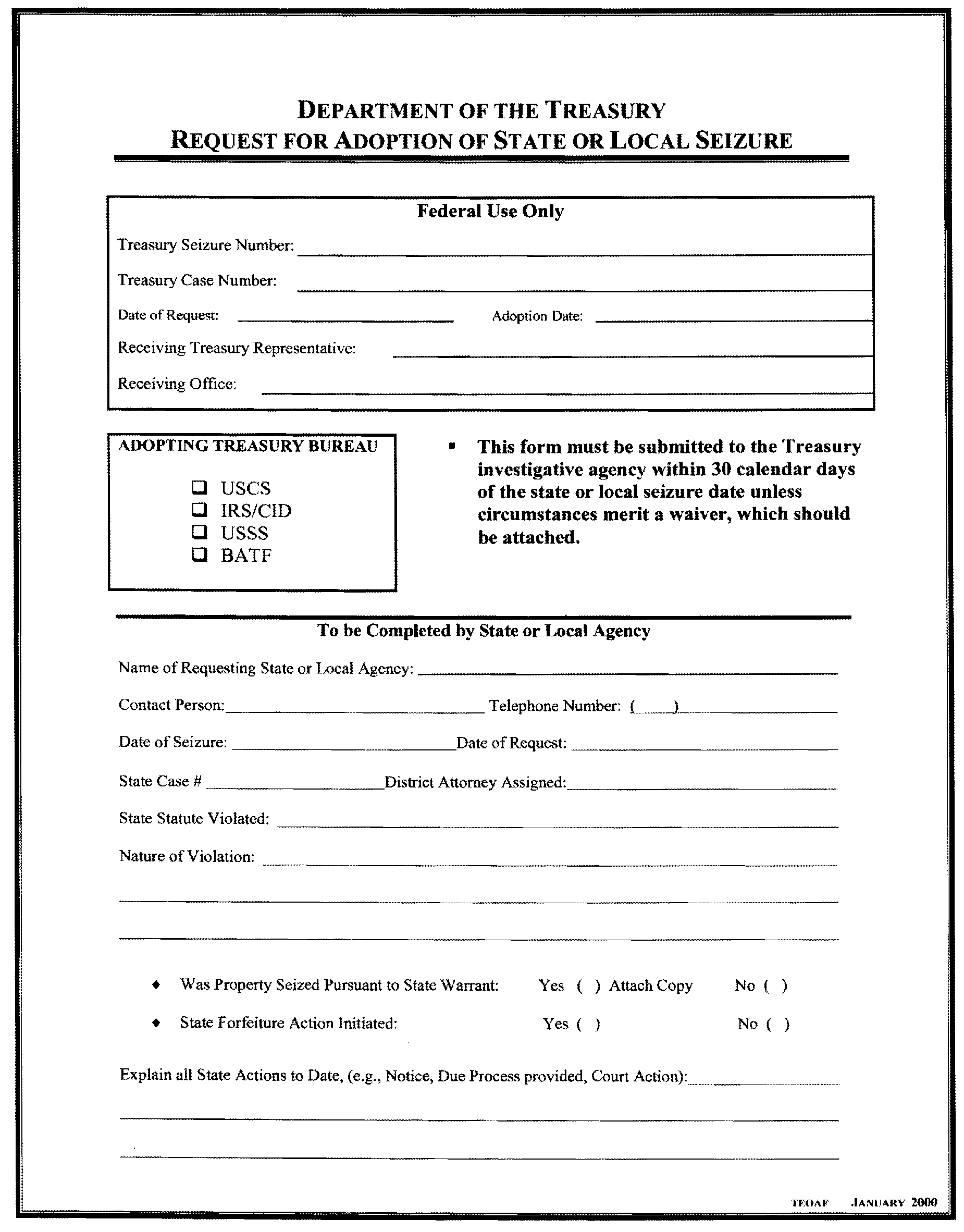
Please click here for the text description of the image.
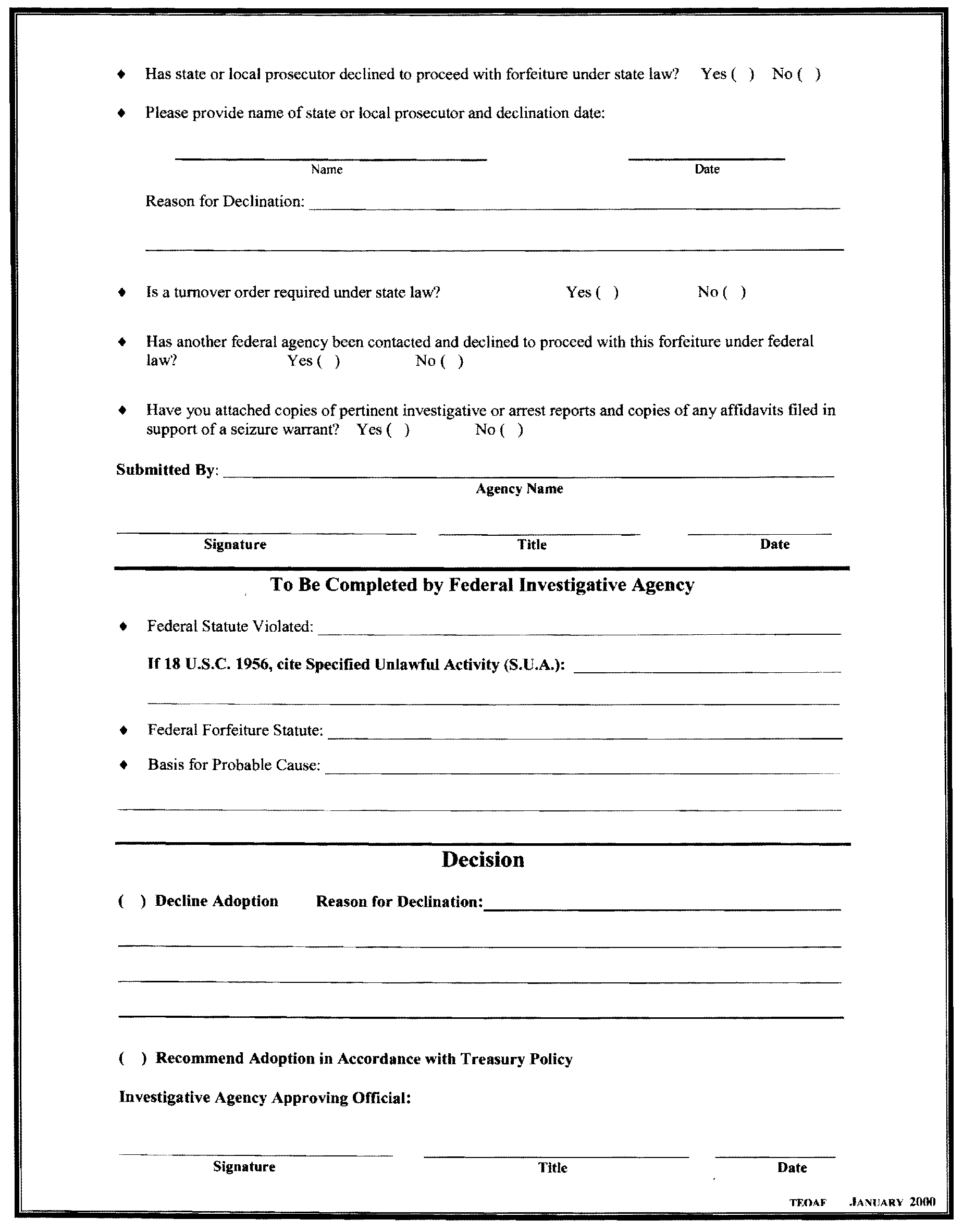
Please click here for the text description of the image.
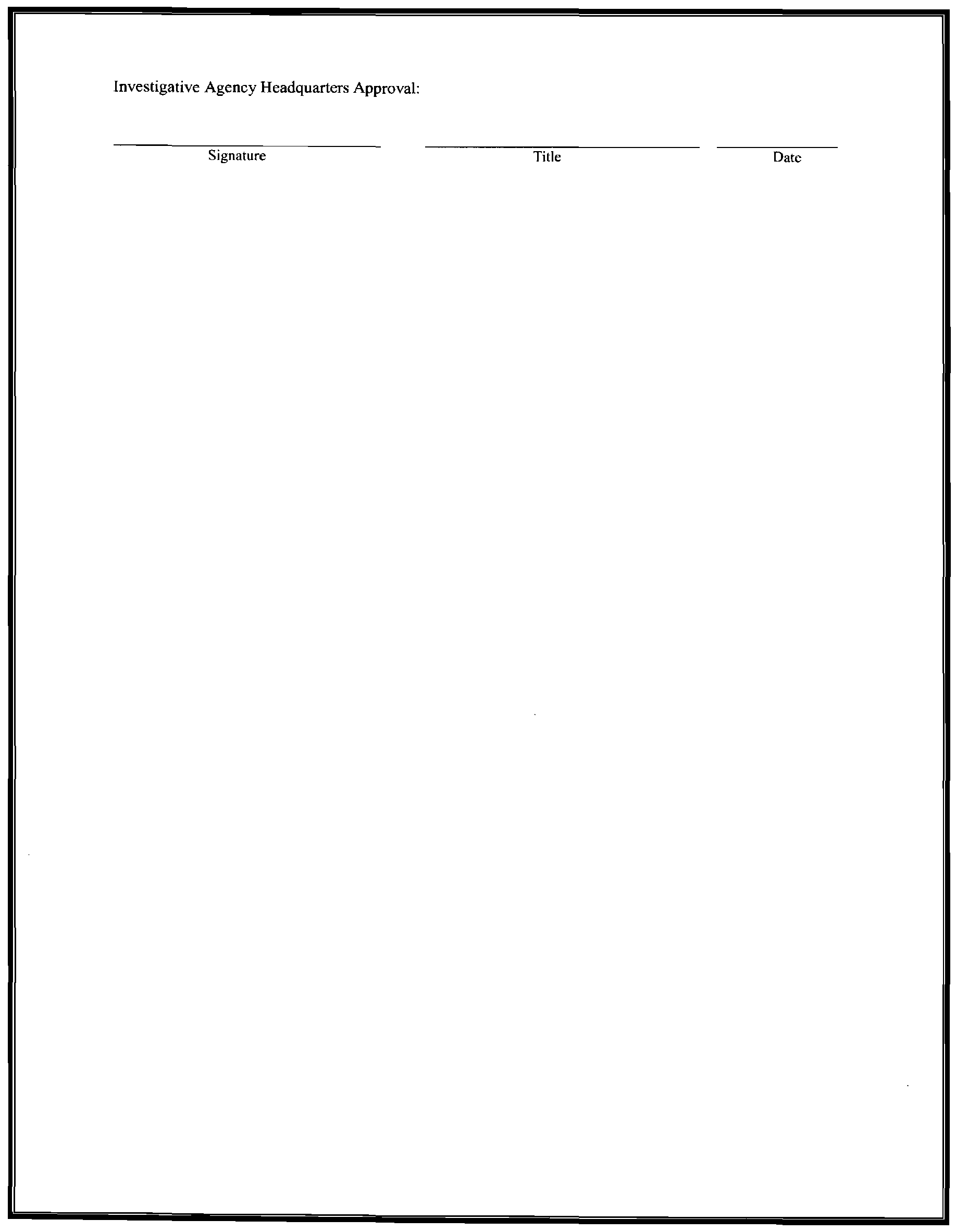
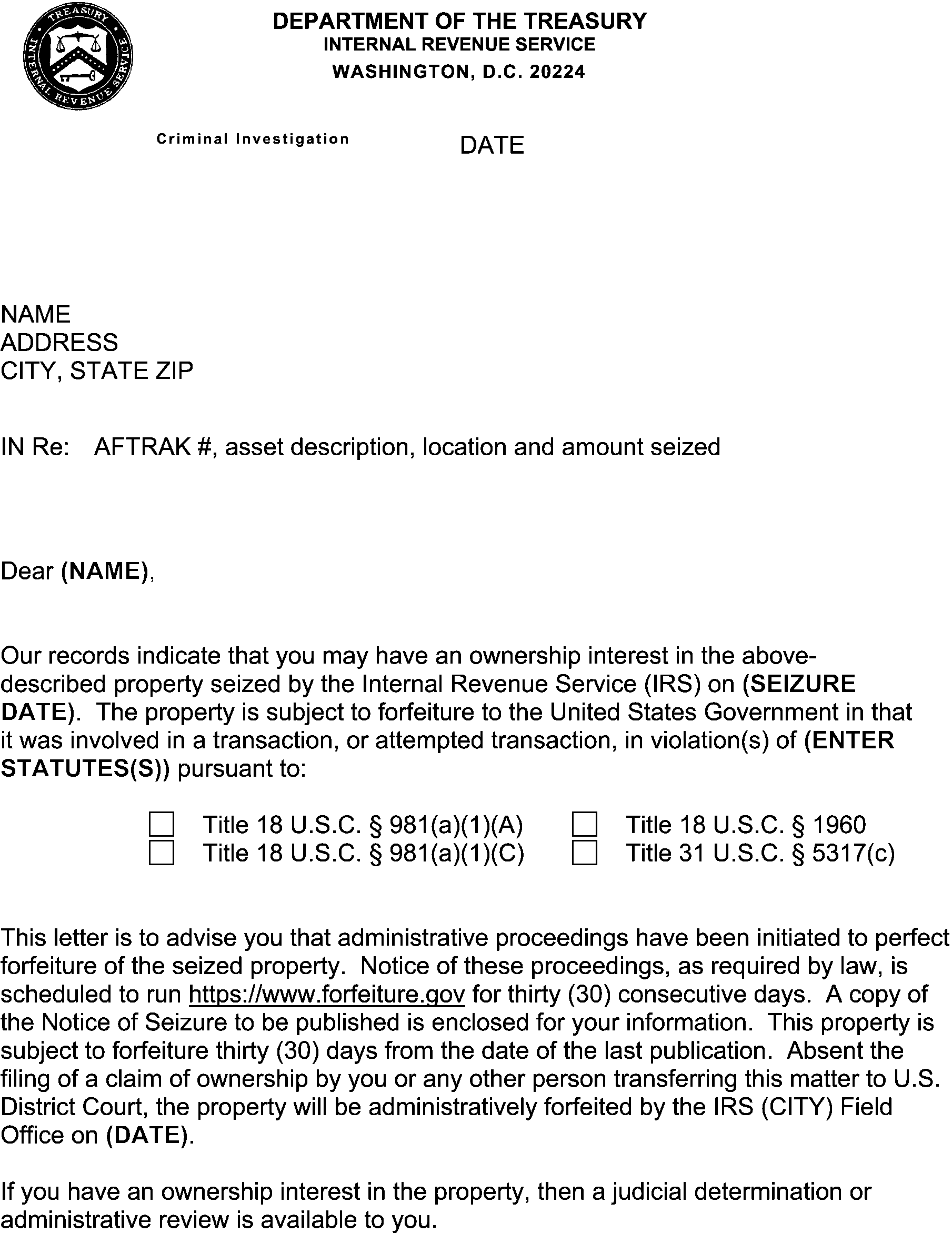
Please click here for the text description of the image.
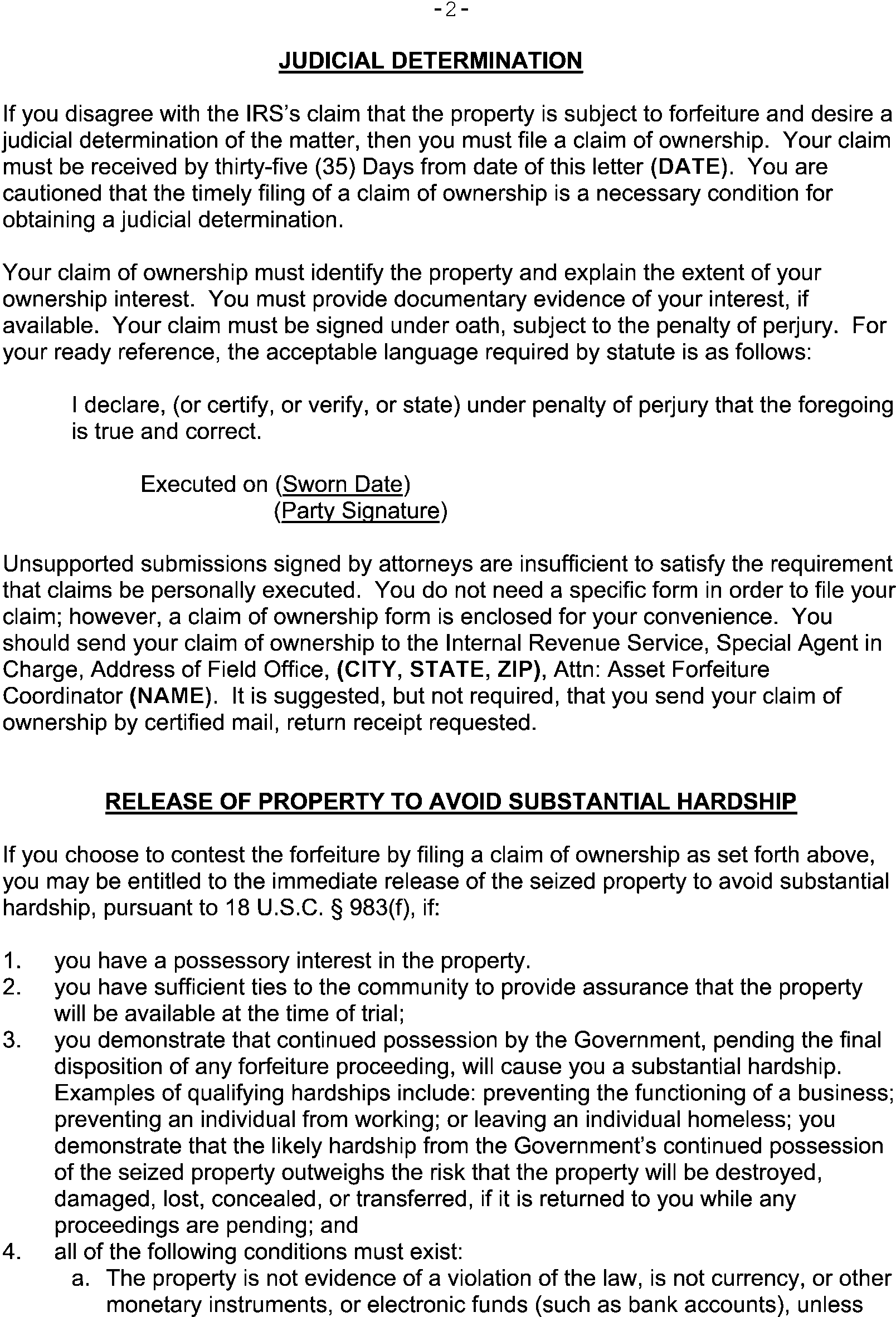
Please click here for the text description of the image.
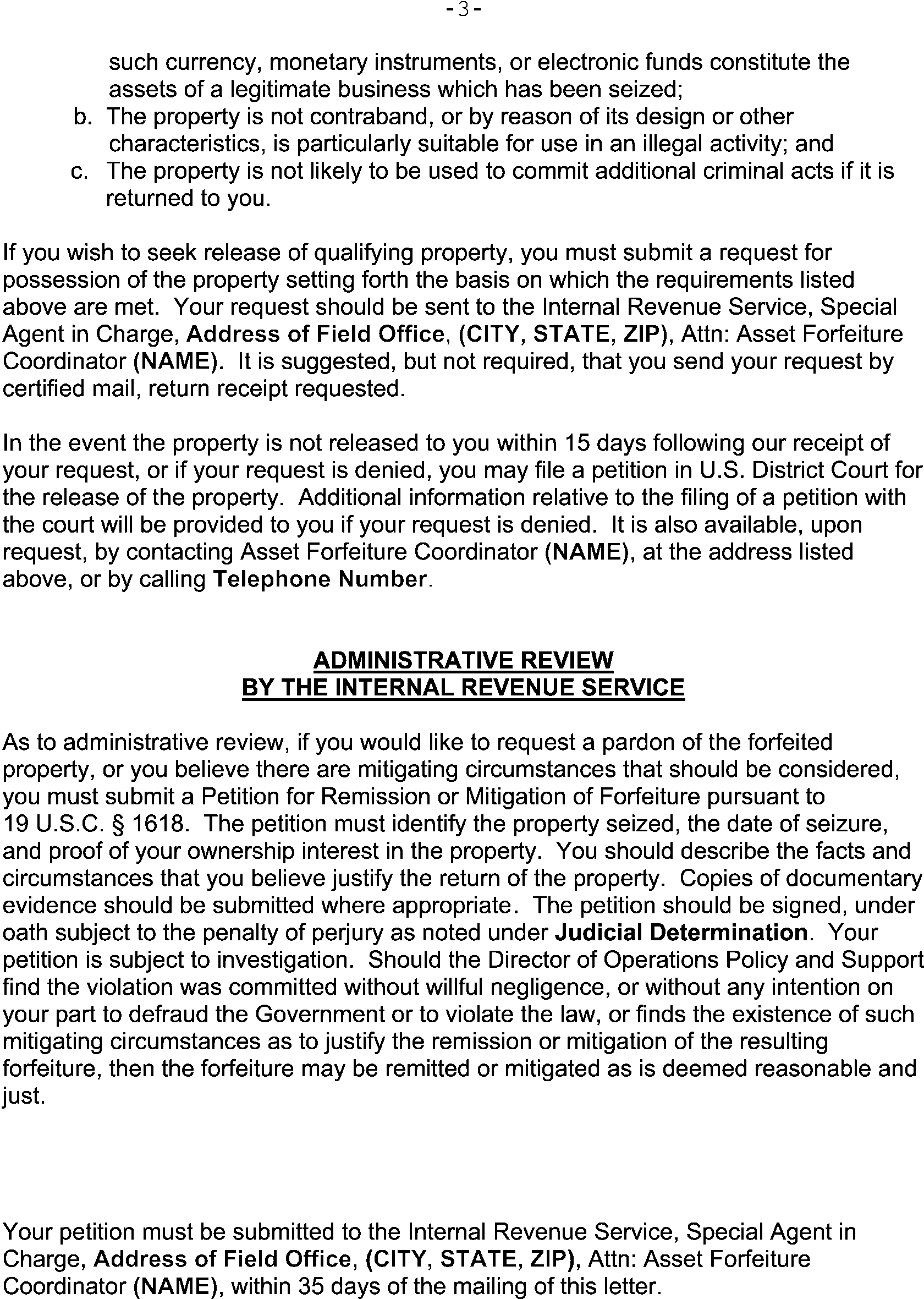
Please click here for the text description of the image.
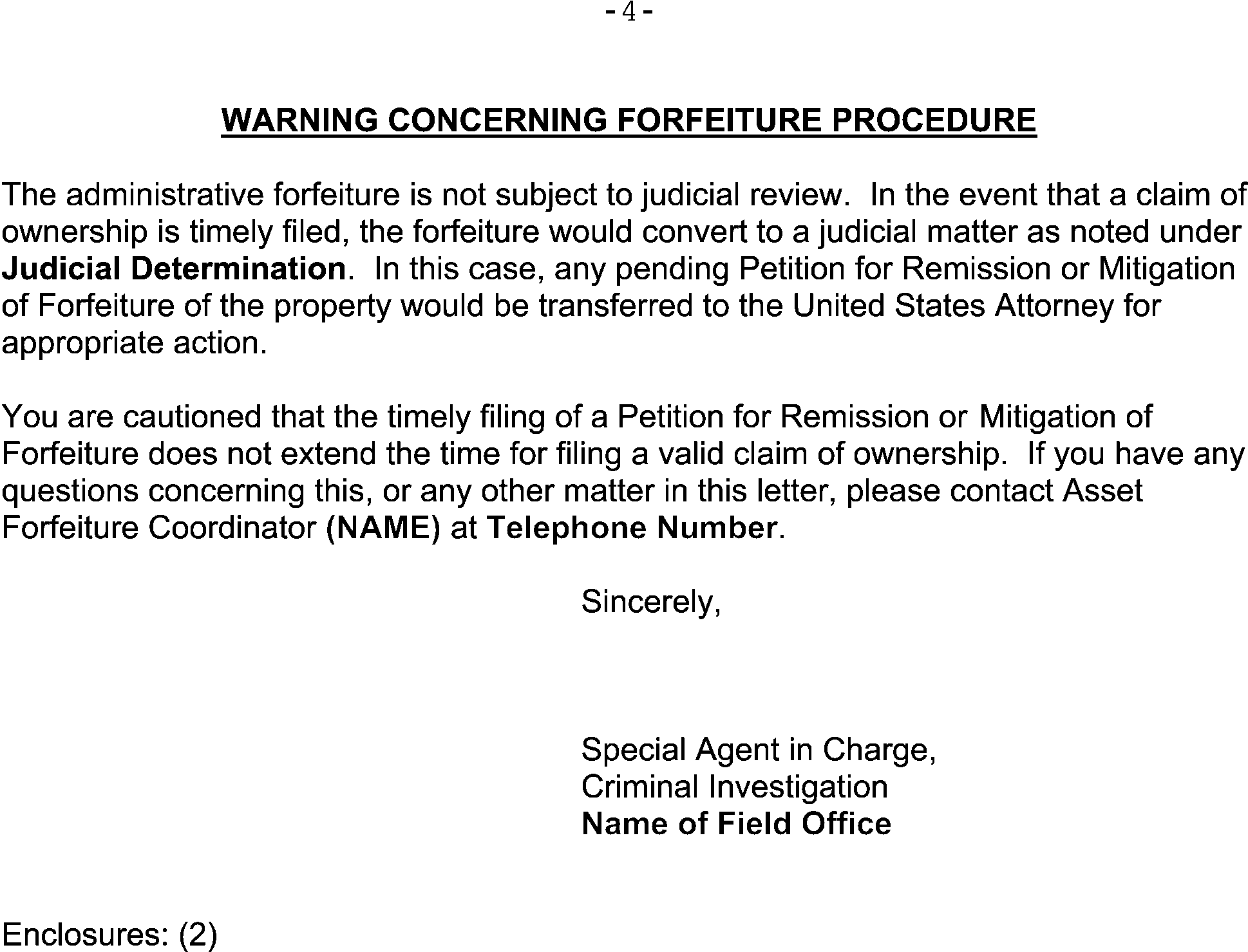
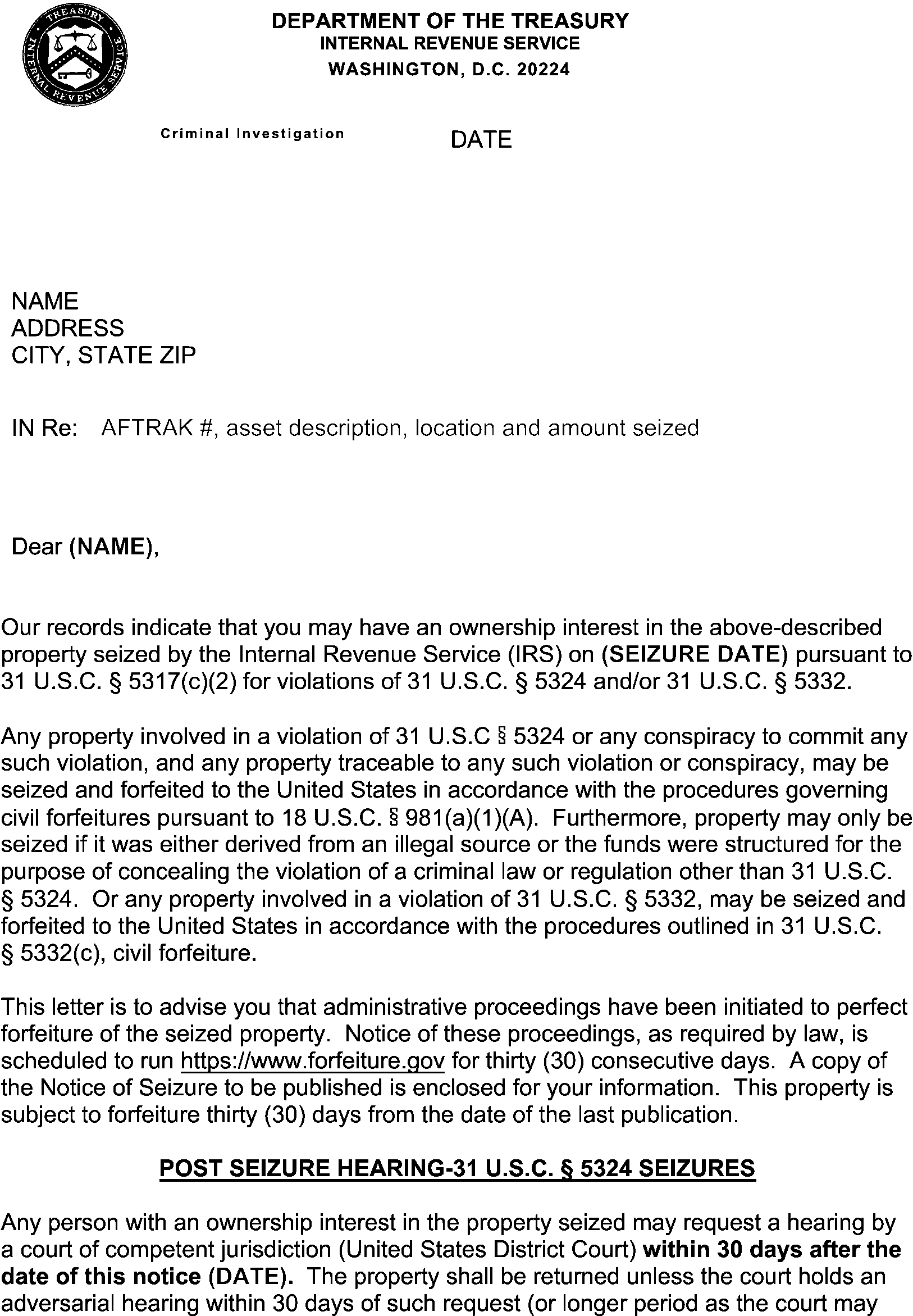
Please click here for the text description of the image.
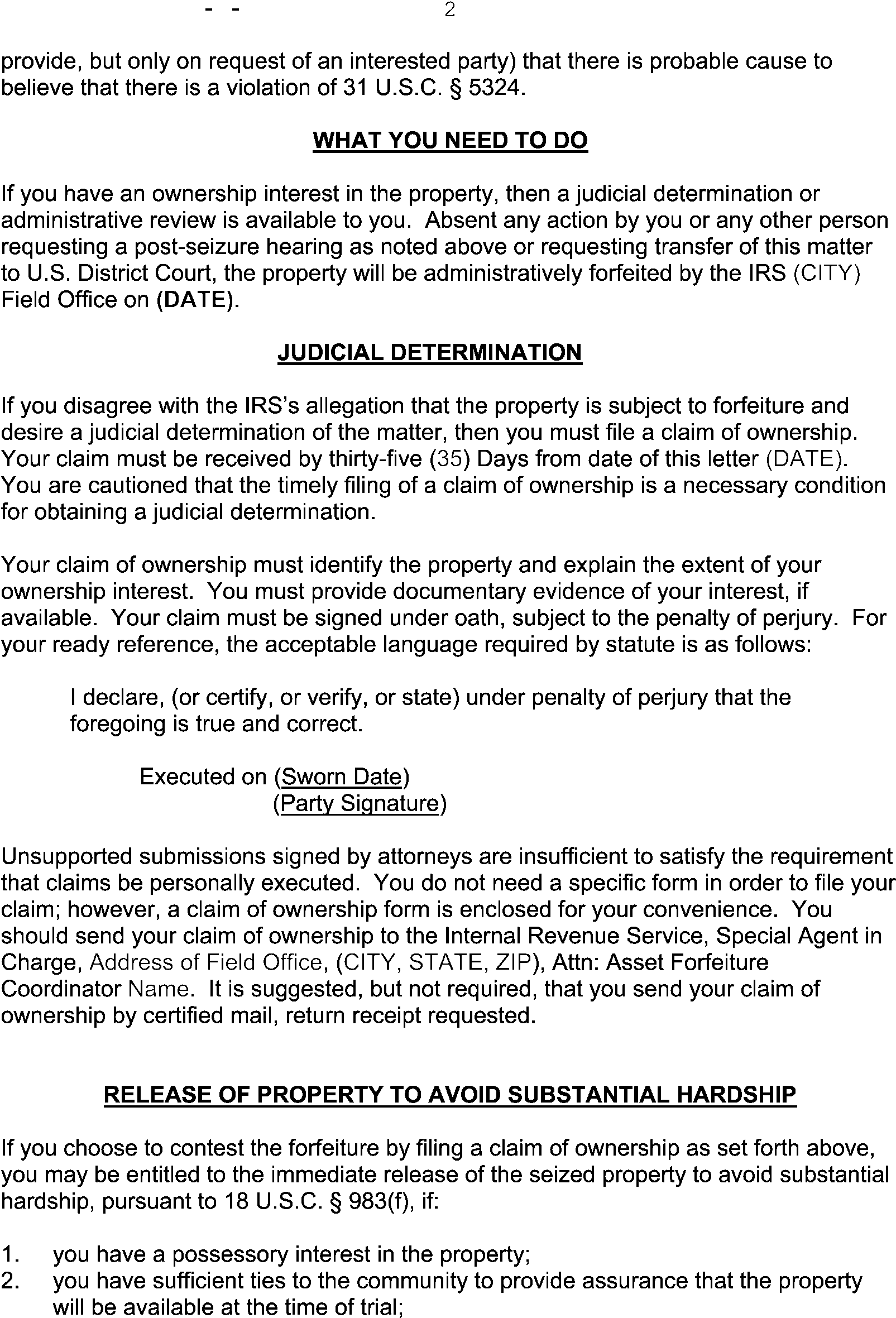
Please click here for the text description of the image.
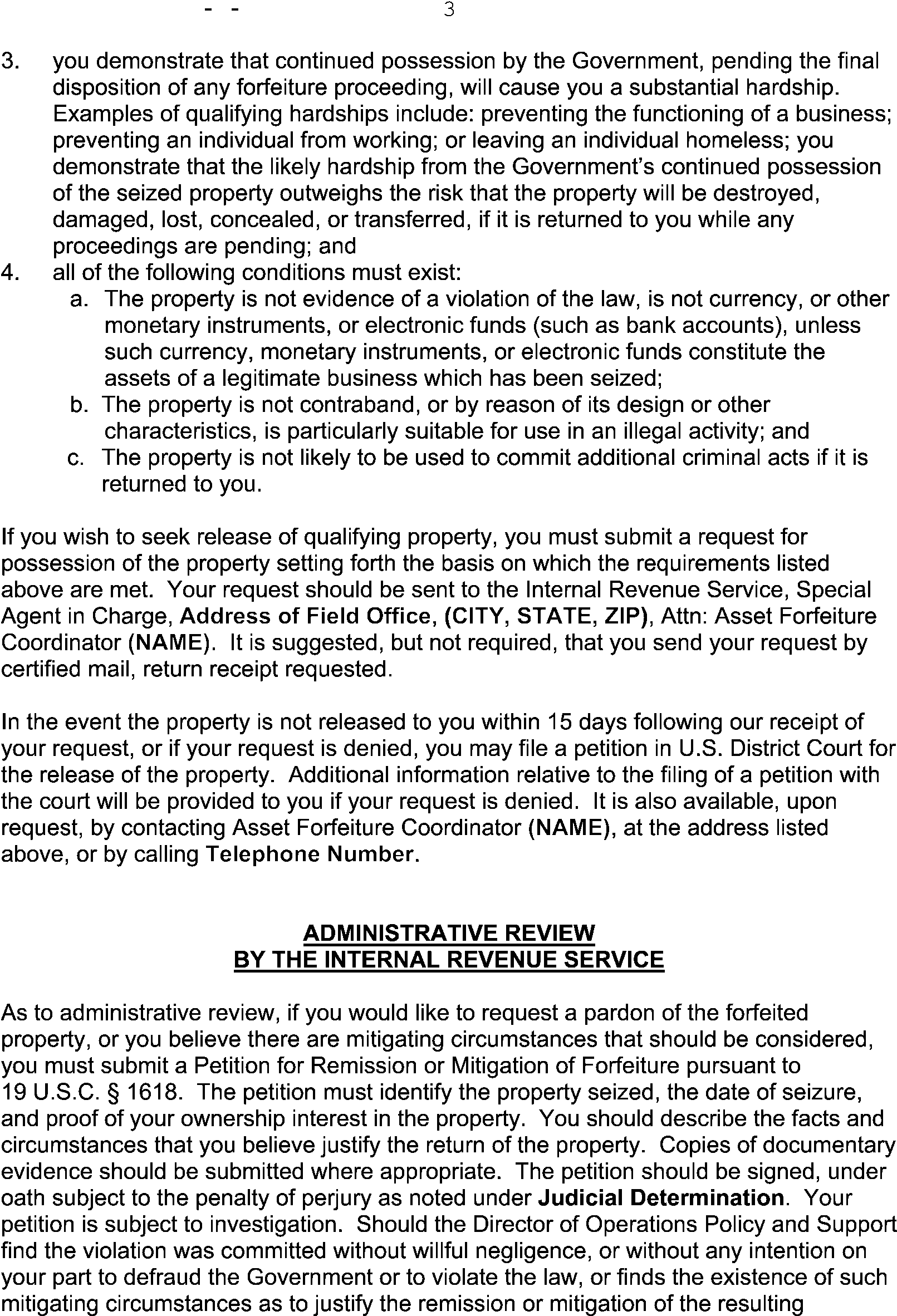
Please click here for the text description of the image.
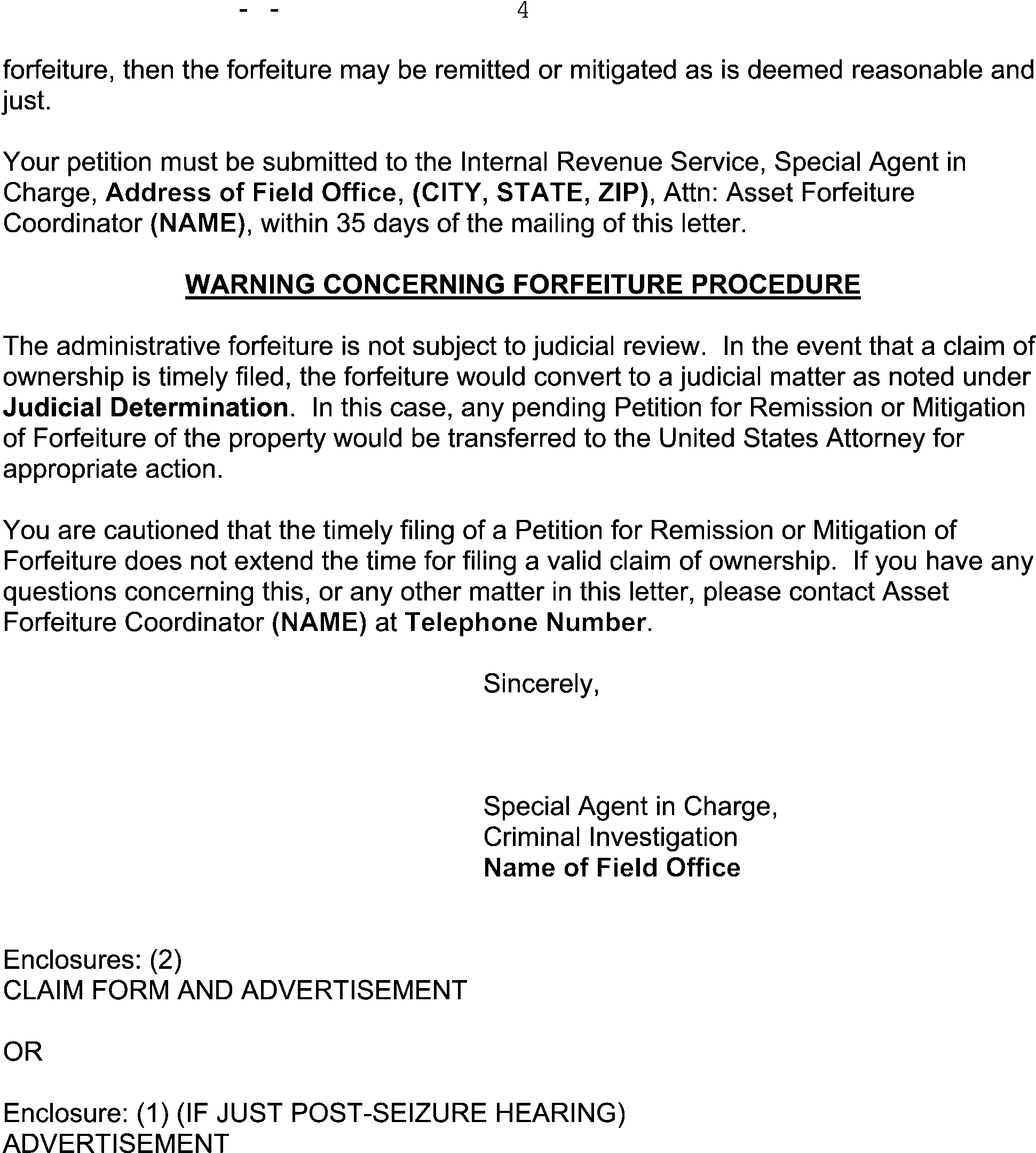
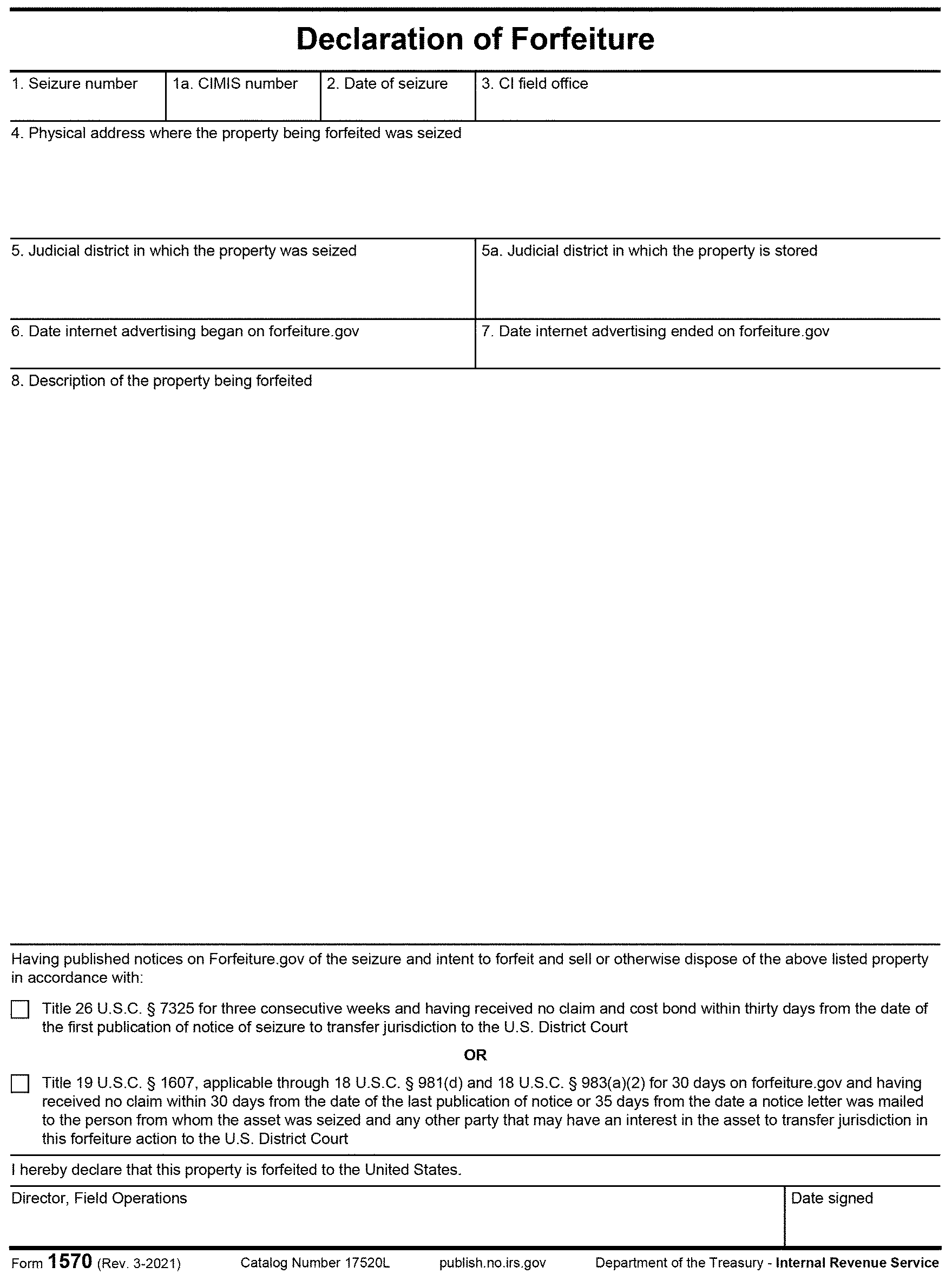

 )
hoặc https:// có nghĩa là bạn đã kết nối an toàn với trang web .gov. Chỉ chia sẻ thông tin nhạy cảm trên các trang web chính thức, an toàn.
)
hoặc https:// có nghĩa là bạn đã kết nối an toàn với trang web .gov. Chỉ chia sẻ thông tin nhạy cảm trên các trang web chính thức, an toàn.

